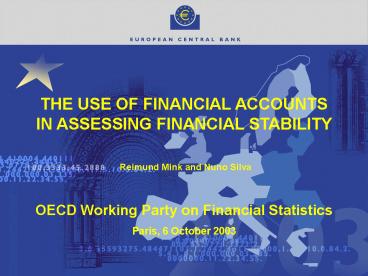THE USE OF FINANCIAL ACCOUNTS IN ASSESSING FINANCIAL STABILITY - PowerPoint PPT Presentation
1 / 14
Title:
THE USE OF FINANCIAL ACCOUNTS IN ASSESSING FINANCIAL STABILITY
Description:
THE USE OF FINANCIAL ACCOUNTS IN ASSESSING FINANCIAL STABILITY. Reimund Mink ... (compliance with standards) Market-based data (stock prices, credit ratings) ... – PowerPoint PPT presentation
Number of Views:59
Avg rating:3.0/5.0
Title: THE USE OF FINANCIAL ACCOUNTS IN ASSESSING FINANCIAL STABILITY
1
THE USE OF FINANCIAL ACCOUNTS IN ASSESSING
FINANCIAL STABILITY
Reimund Mink and Nuno Silva
OECD Working Party on Financial Statistics Paris,
6 October 2003
2
FINANCIAL ACCOUNTS IN ASSESSING FINANCIAL
STABILITY
Contents of the presentation
- Quarterly MUFA
- Financial stability analysis
- Uses of MUFA in financial stability analysis
- Macro-prudential analysis at the ECB
- Quarterly MUFA - way forward
3
QUARTERLY MUFA
The ESA 95 concepts and definitions
- Residency and institutional sectors
- Financial assets
- Sequence of accounts
- Market valuation and accrual accounting
- Original maturity
4
QUARTERLY MUFA
The main uses of MUFA
Monetary policy analysis
Financial stability analysis
Statistical quality analysis
5
QUARTERLY MUFA
Publication of data
- Quarterly press release
- Quarterly data
- - ECB Monthly Bulletin, Table 6.1
- - ECB Monthly Bulletin, Table 6.2
- - ECB Statistical Pocket Book, Table 7.1 - 7.3
- Annual data
- - ECB Monthly Bulletin, Table 6.3
- - ECB Statistical Pocket Book, Table 6.1 and 6.2
6
QUARTERLY MUFA
Example Table 1 of the Press Release
7
QUARTERLY MUFA
Input for monetary policy analysis
- Commentary in the ECB Monthly Bulletin
- Quarterly briefing note to the ECB Executive Board
8
FINANCIAL STABILITY ANALYSIS
The ECB definition
A condition whereby the financial system is able
to withstand shocks without giving way to
cumulative processes, which impair the allocation
of savings to investment opportunities and the
processing of payments in the economy
9
FINANCIAL STABILITY ANALYSIS
Components of macro-prudential analysis
MPIs
Financial accounts
STRESS TESTS
Macroeconomic data (prices, interest and exchange
rates)
Market-based data (stock prices, credit ratings)
Macro-prudential analysis
Structural information (relative size, ownership
of corporations)
Qualitative information (compliance with
standards)
Financial accounts
10
USES OF MUFA IN FINANCIAL STABILITY ANALYSIS
The contribution
- Integrated approach (sectors, instruments and
stocks/flows) - Contribution to the general Improvement in
statistics - Source to derive MPIs for the non-financial
sectors - Financial innovation and its implications
- Relationship with the real side of the economy
11
USES OF MUFA IN FINANCIAL STABILITY ANALYSIS
Methodological issues
- Residency criterion
- Aggregation and consolidation
- Valuation and accrual accounting
- Maturity definition
12
MACRO PRUDENCIAL ANALYSIS AT THE ECB
Article 3.3 of the ESCB Statute
Contribute to the smooth conduct of policies
pursued by the competent authorities relating to
the prudential supervision of credit institutions
and the stability of the financial system
13
MACRO PRUDENCIAL ANALYSIS AT THE ECB
The regular outputs
- The annual macro-prudential report on the EU
banking system - The annual report on the structural developments
of the EU banking system - The ECB biannual Financial Stability Review
14
QUARTERLY MUFA - WAY FORWARD
The future of quarterly MUFA
- Extend the current TFIs for the non-financial
sectors and ICPFs to seven sectors - Improve the timeliness (90 days)
- Complete the instrument coverage and the link
between stocks and flows - Sectoral accounts
- Quarterly who-to-whom system































